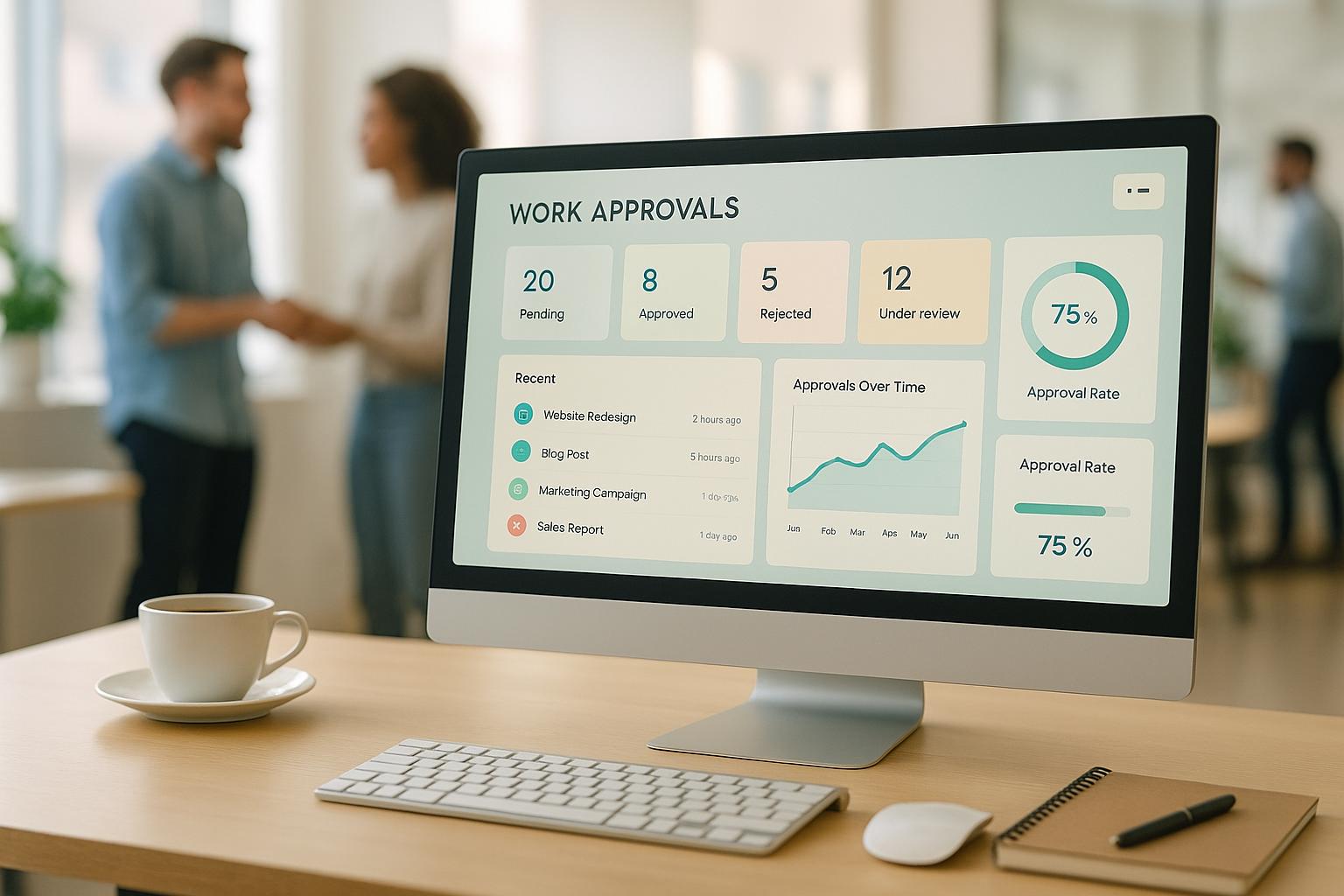Struggling with slow client feedback? Here's how to fix it.
Managing client feedback can be a headache, especially if emails get lost, tools feel clunky, or approvals drag on for days. A streamlined system can save time, improve communication, and keep projects on track.
Key steps to simplify feedback:
- Use simple tools like WhatsApp for real-time updates.
- Set clear goals for quality, response times, and approvals.
- Provide straightforward instructions for feedback and approvals.
- Schedule regular reviews and plan for urgent updates.
For example, BuildPro Inc. reduced approval times from 3 days to a few hours by integrating Workproofs.com with WhatsApp. This approach sped up projects and improved client satisfaction.
Quick Tip: Choose tools that are mobile-friendly, require no extra logins, and allow one-tap approvals to make the process easy for everyone.
Want faster, clearer feedback? Start by simplifying your system.
3 Steps to Organize Customer Feedback in a Small Business ...
Step 1: Set Up Your Feedback System
Build a feedback system by outlining goals, providing clear instructions, and selecting the right communication tools.
Define Project Goals
Set specific feedback objectives in three key areas:
- Quality Standards: Establish measurable benchmarks for deliverables.
- Response Times: Set clear maximum timeframes for receiving and addressing feedback.
- Approval Rates: Monitor the percentage of work approved on the first attempt.
Once these goals are in place, ensure all parties understand what’s expected to achieve them.
Provide Clear Instructions
Offer straightforward guidelines for both clients and team members. Keep instructions simple and easy to follow:
| Instruction Component | Purpose | Example |
|---|---|---|
| Visual Guidelines | Clarify what needs to be submitted | "Submit clear photos showing completed work" |
| Approval Criteria | Specify what’s required for acceptance | "All items must be visible and well-lit" |
| Response Format | Explain how to provide feedback | "Use single-tap approve/reject options" |
After setting these instructions, focus on selecting communication tools that allow fast and transparent interactions.
Choose Communication Tools
Select communication methods that are easy to use and encourage active participation. Keep these factors in mind:
- Accessibility: Pick a platform that works smoothly on various devices.
- Visual Features: Use tools that allow quick sharing of visual proof, especially for industries like construction or creative services.
- Integration: Ensure the platform fits into your current workflow. For instance, Workproofs.com integrates with WhatsApp, enabling teams to share and approve work directly through their messaging app.
Step 2: Select Feedback Tools
With your feedback system ready, it's time to pick tools that make interactions smoother and more efficient.
Prioritize Simplicity
The best tools are those that require little to no training. Look for platforms that offer:
- Mobile-friendly access and simple interactions: Allow approvals with a single tap from any device.
- No login hassles: Avoid tools that require multiple passwords or accounts.
- Intuitive design: Ensure everyone, regardless of technical skill, can use the platform easily.
For instance, Workproofs.com integrates directly with WhatsApp, letting users submit feedback without needing additional training. After identifying user-friendly tools, make sure they also cater to remote work needs.
Ensure Remote Compatibility
Modern feedback tools should support remote work to keep everything running smoothly. Look for features like:
| Feature | Benefit | Impact |
|---|---|---|
| Visual Proof Sharing | Quick sharing of photos and files | Reduces confusion and miscommunication |
| Instant Notifications | Real-time updates on submissions | Speeds up approvals |
| Secure Storage | Automatic backups of approved work | Ensures accountability and easy access |
According to recent data, businesses using WhatsApp-based approval systems cut follow-up time with subcontractors by 60%. These features are essential for creating an efficient, automated feedback process.
Opt for Tools That Save Time
Look for tools that reduce manual work and simplify feedback processes. Key features to consider include:
- Automated tracking: Keep tabs on submission and approval statuses effortlessly.
- Quick-response options: Enable one-tap decisions for approvals or rejections.
- Secure archiving: Automatically store approved submissions for future reference.
The goal is to choose tools that streamline workflows without compromising communication.
"Workproofs.com makes it simple: subcontractors send proofs, you approve or reject - all within WhatsApp."
sbb-itb-57e8e01
Step 3: Plan Feedback Times
A well-organized feedback schedule keeps your project on track. Here's how to set up a timeline that works for everyone.
Schedule Regular Reviews
To keep things moving, set up consistent feedback checkpoints that fit your project milestones and your client's availability. Here's a quick guide:
| Project Type | Review Frequency | Best Time to Schedule |
|---|---|---|
| Fast-paced | 2-3 times per week | Morning hours (9–11 AM) |
| Standard | Weekly | Mid-week (Tuesday–Thursday) |
| Long-term | Bi-weekly | End-of-week review |
When planning reviews, consider time zones and client preferences. If you're working with a remote team, pick times that overlap with business hours for everyone. Reserve specific slots for feedback sessions instead of squeezing them between other meetings. This ensures enough time for detailed discussions and avoids rushed decisions.
This approach ties in with your tools and guidelines, creating a smooth feedback process. Along with scheduled reviews, include quick-response methods for handling urgent updates.
Allow Quick Updates
Scheduled reviews are essential, but you also need a plan for urgent feedback or approvals that can't wait.
For handling time-sensitive updates, try these steps:
- Use familiar messaging tools for quick decisions
- Set clear criteria for what qualifies as urgent feedback
- Define priority levels so teams know when to use rapid feedback channels versus waiting for the next scheduled review
Step 4: Handle Client Input
Once your system and tools are set up, the next step is managing client input effectively.
Use Feedback Forms
Feedback forms are a great way to gather clear, actionable input from clients. By structuring the forms, you can avoid vague comments and keep workflows moving smoothly. Here’s what to include:
| Form Section | Purpose | Example Fields |
|---|---|---|
| Project Details | Identify the work | Project name, milestone, date |
| Specific Elements | Pinpoint exact items | Component name, page number, feature |
| Change Requests | Detail modifications | What to change, why it's needed |
| Priority Level | Set importance | High/Medium/Low, deadline required |
Choose tools that make it easy for clients to submit their feedback while keeping everything organized. For example, Workproofs.com simplifies this process by integrating with platforms like WhatsApp.
Rank Feedback Importance
Not all feedback is equally urgent. To manage it effectively, prioritize based on these criteria:
| Priority Level | Impact Criteria | Response Time |
|---|---|---|
| Critical | Affects core functionality or deliverables | Same business day |
| High | Important but not blocking progress | Within 48 hours |
| Medium | Enhances project quality | Within 1 week |
| Low | Nice-to-have improvements | Next review cycle |
Assess feedback based on how urgent it is to the client and its impact on the project. Once prioritized, keep clients informed about progress to build trust.
Share Progress Updates
Regular updates help clients stay in the loop about how their feedback is being handled. Here's how to do it:
-
Visual Proof and Status Tracking
Share visual evidence of updates and use a clear status system to show progress:
- Received: Feedback has been logged and reviewed.
- In Progress: Changes are currently being implemented.
- Completed: Updates are finished and ready for review.
- Approved: The client has confirmed the changes.
-
Regular Updates
Provide updates on:
- What feedback has been addressed.
- The current status of pending changes.
- Expected completion dates for remaining items.
This approach keeps clients informed and reassured that their input is being taken seriously.
Conclusion: Turn Feedback Into Better Results
Refining your feedback process, as outlined earlier, can lead to better project outcomes. A well-structured system not only improves results but also strengthens trust. By keeping your feedback process simple and accessible, you set the stage for consistent success.
Here are three major benefits of an effective feedback approach:
Faster Project Completion
Using tools like WhatsApp for feedback allows teams to quickly address changes without relying on complicated software. This quick turnaround minimizes delays and keeps projects on track.
Improved Quality Control
Organized feedback and clear documentation ensure no critical updates are overlooked. Keeping detailed records of approvals and revisions makes it easier to track progress and maintain accountability throughout the project.
Increased Client Confidence
Frequent updates and a clear process reassure clients that their input matters. Transparent communication fosters trust and shows clients that your team is committed to delivering results that meet their expectations.
FAQs
How can WhatsApp make the client feedback process more efficient?
Using WhatsApp for client feedback simplifies communication and speeds up the approval process. Subcontractors can easily submit proofs of work - like photos, files, or text - directly through the app, eliminating the need for complex tools or lengthy training. Managers can quickly review submissions and approve or request changes with just one tap.
This streamlined approach ensures all work is reviewed and approved before it reaches your clients, reducing errors and improving accountability. It’s an efficient way to maintain high-quality standards while keeping the process simple for everyone involved.
Why is it important to set clear goals and instructions for client feedback?
Setting clear goals and instructions for client feedback is essential to ensure the process is efficient, productive, and stress-free for everyone involved. When clients understand exactly what feedback is needed and how to provide it, it reduces misunderstandings, saves time, and helps deliver better results.
Clear guidelines also create a structured framework for addressing feedback, making it easier to prioritize tasks and implement changes effectively. This approach fosters stronger communication, improves collaboration, and helps maintain a positive relationship with clients.
How can businesses effectively prioritize and handle feedback based on urgency?
To manage feedback effectively, businesses should first categorize it by urgency and impact. Start by identifying which issues are critical to operations or client satisfaction and address those immediately. Less urgent feedback can be scheduled for later review or bundled into future updates.
To streamline this process, consider using tools that simplify feedback collection and approval workflows. For example, platforms like Workproofs.com allow managers to quickly review and approve submissions, ensuring that urgent tasks are prioritized without unnecessary delays. This not only improves accountability but also helps maintain strong client relationships by keeping the feedback loop efficient and responsive.


